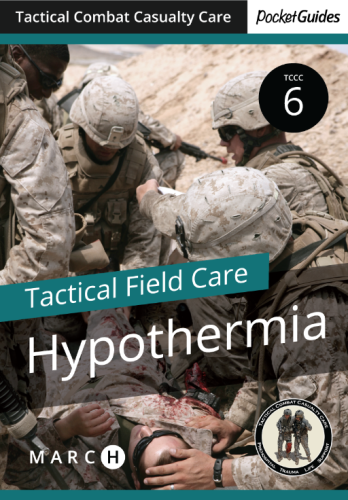Support the development of the TCCC project in Ukraine
Introduction
After completing the Circulation portion of Tactical Field Care, the next focus is on Hypothermia.
The Hypothermia portion of Tactical Field Care consists of the techniques recommended for the prevention and treatment of hypothermia.
Objective
- DESCRIBE how to prevent blood clotting problems caused by hypothermia.
Video: TFC Hypothermia.
Guidelines and Key Points
Hypothermia Prevention
- Minimize casualty’s exposure to the elements. Keep protective gear on or with the casualty if feasible.
- Replace wet clothing with dry if possible. Get the casualty onto an insulated surface as soon as possible.
- Apply the Ready-Heat Blanket from the Hypothermia Prevention and Management Kit (HPMK) to the casualty’s torso (not directly on the skin) and cover the casualty with the Heat-Reflective Shell (HRS).
- If an HRS is not available, the previously recommended combination of the Blizzard Survival Blanket and the Ready-Heat Blanket may also be used.
- If the items mentioned above are not available, use dry blankets, poncho liners, sleeping bags, or anything that will retain heat and keep the casualty dry.
- Warm fluids are preferred if IV fluids are required.
- Key Points:
The Ready-Heat Blanket can produce temperatures reaching 104°F for several hours, and works for up to 8 hours. Avoid direct contact with bare skin as thermal burns are possible. Keep camouflage top or T-shirt on and place Ready-Heat Blanket over the fabric.
Ready-Heat Blankets may not work as well at high altitudes. The lower partial pressure of oxygen at high altitudes may not be enough to sustain the chemical reaction required to generate heat.
Remember!!! We’re not talking about hypothermia in the usual sense, which is dying from cold exposure. We are talking about keeping your blood clotting system working! Casualties in shock are unable to generate body heat effectively.
Even a small decrease in body temperature can interfere with blood clotting and increase the risk of bleeding to death. Hypothermia is much easier to prevent than to treat!
Summary:
- Minimize the casualty's exposure and keep protective gear on if feasible.
- Apply the Ready-Heat Blanket and cover the casualty with the Heat-Reflective Shell (HRS).
- Warm IV fluids if they are required.
- Prevent hypothermia before it happens.
You can discuss this material on the TCCC forum




















